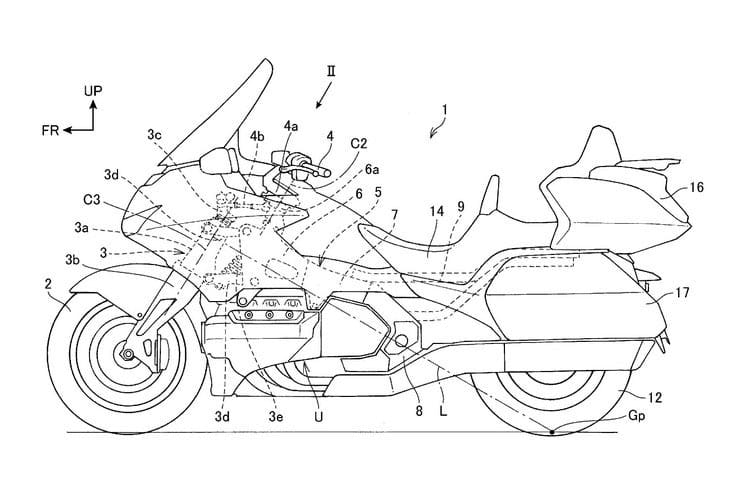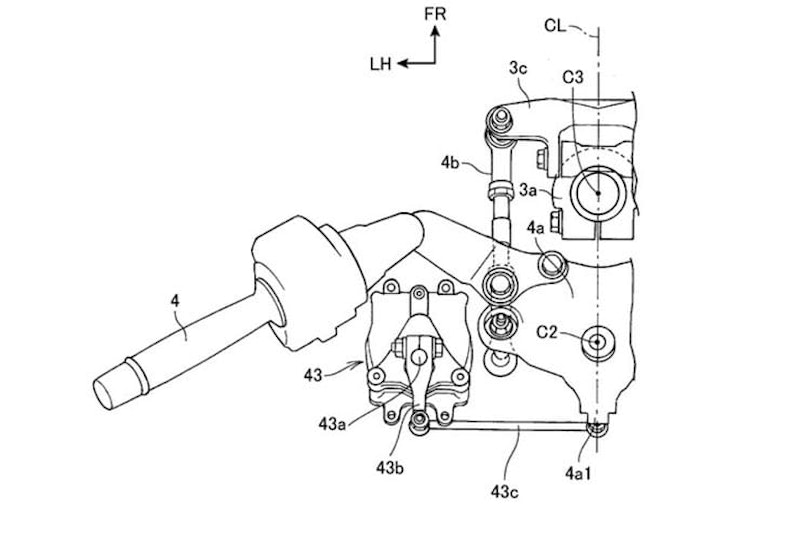Honda developing anti-topple technology
By Ben Purvis
Motorcycle Journalist
05.04.2023
New anti-drop system is illustrated on a Gold Wing in Honda’s patent application
Only a week ago we saw Yamaha’s prototype for an anti-crash bike using a self-steering system it hopes to productionise in the coming years. Now Honda has filed a patent application for its own take on the idea – one that’s specifically intended to solve the problem of keeping control of a bike as you push it around your garage.
That might not sound like the sort of life-saving ambition that’s normally associated with rider-assistance systems but when it comes to selling points, there’s no question that a bike that’s essentially un-droppable is a tempting proposition. Unsurprisingly, the patent shows the technology fitted to a Gold Wing, Honda’s biggest, heaviest, highest-tech and most expensive model, which is surely the first in line to get the company’s next-generation rider-aids.
Steering servo is also intended to be used for other rider-assistance systems
To be fair to Honda, this new system to prevent manoeuvring accidents is essentially a free spin-off from designs it’s already developing with more life-saving matters in mind. Honda has filed a host of patent applications related to steering-assistance for bikes, often with the Gold Wing illustrated as host model, and the anti-toppling system is made using exactly the same components.
The main element of the setup is a steering servo, attached to the ’Wing’s girder-style forks and able to turn them in response to commands from the on-board computer. The same servo is at the heart of several patents from the company as part of lane-assistance and accident-avoidance systems. It’s not dissimilar from the actuator used on Yamaha’s new prototype or the motocross bikes that Yamaha revealed last year. The servo can essentially work as a steering damper and as power-assistance for the steering, but also override the rider’s own inputs when needed.
In the new patent application the servo is used while you’re pushing the bike around. It uses inputs from the bike’s IMU and lean sensors, so while you stand to one side of the bike and move it forwards or backwards the bike monitors its own lean-angle and will automatically steer to prevent it from getting too extreme. While moving a bike around is easy while it’s upright, as it starts to lean the weight you have to support increases rapidly (particularly if it starts to topple away from the side you’re standing on). The Honda system aims to stop that from happening.
New idea intends to make it easier to push bikes around without dropping them
The latest Gold Wing DCT already has a low-speed manoeuvring system allowing it to trundle forwards and backwards under its own power at walking speed and using the ‘up’ and ‘down’ shift buttons on the bars for control. The addition of a steering assist element that turns the front wheel to stop the bike from leaning over too much while it’s being manoeuvred about means that the final element that can be troublesome when parking such a big, heavy bike is eliminated.
Way back in 2017 Honda demonstrated that it’s capable of making a motorcycle that can move around at walking pace without any help from a rider at all – the Riding Assist concept had that ability – so it’s not a huge leap to imagine that a more subdued version of that system reaching production, with the next-gen Gold Wing the most obvious first model to benefit from the technology. The last big change to the Gold Wing was for the 2018 model year, so revisions could be due sooner rather than later. Over the last few years we’ve also seen several other patents related to a revised Gold Wing, including front and rear radars, so it’s clear there’s a substantial amount of development work underway to make sure the next-gen version leapfrogs rivals in terms of tech.
Share on social media:

